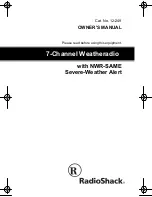
29
EN
Calibration mode
Press the HISTORY button for 8 seconds during normal mode to enter
calibration mode. The wind indicator will start flashing. You can skip individual
settings by pressing the SET button. Press the + or MIN/MAX button to
select the unit. Press and hold the + or MIN/MAX button to adjust in larger
increments. Press the HISTORY button again to exit the calibration mode. The
following data can be calibrated:
•
Wind speed (default is 1.0; adjustment from 0.75 to 1.25 possible)
•
Precipitation data (preset is 1.0; adjustment from 0.75 to 1.25 possible)
• Precipitation recording
• Humidity outside
• Humidity inside
• internal temperature
Calibration of wind speed
The wind speed is the most sensitive. The sensor should not be placed near
buildings, trees, etc. Many installation locations are not ideal and installing
the weather station on a roof can be difficult. You can calibrate the weather
station with a wind speed multiplier to avoid errors. Without a calibration
source, measuring wind speed can be difficult. It is recommended to use a
calibrated anemometer and a constant high speed vane.
Temperature Calibration
Temperature measurement errors can occur when a sensor is exposed to a
heat source (such as a building, the ground, or direct sunlight in a very hot
environment). We recommend using a mercury or petroleum thermometer
to calibrate the temperature, as digital and bi-metal thermometers have
too high an error rate. Using the data from a local weather station will also
result in data corruption due to different location, different measurement
time (airport weather stations are updated only once per hour) and possible
calibration errors (many official weather stations have not been properly
installed or calibrated). Place the sensor in a shady environment next to an
additional thermometer and allow the sensor 48 hours to stabilize. Compare
the temperature measured by the thermometer with the instrument‘s
temperature display and adjust it accordingly.
















































